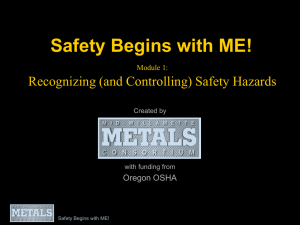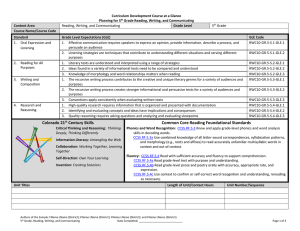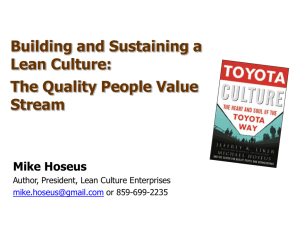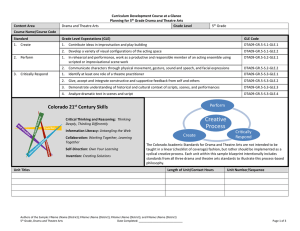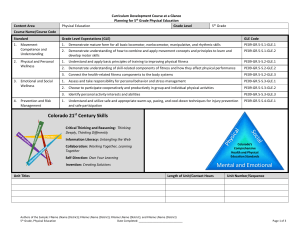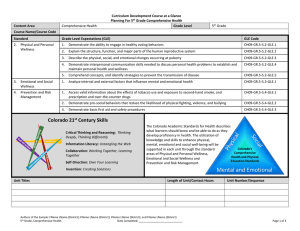Document 15590576
advertisement
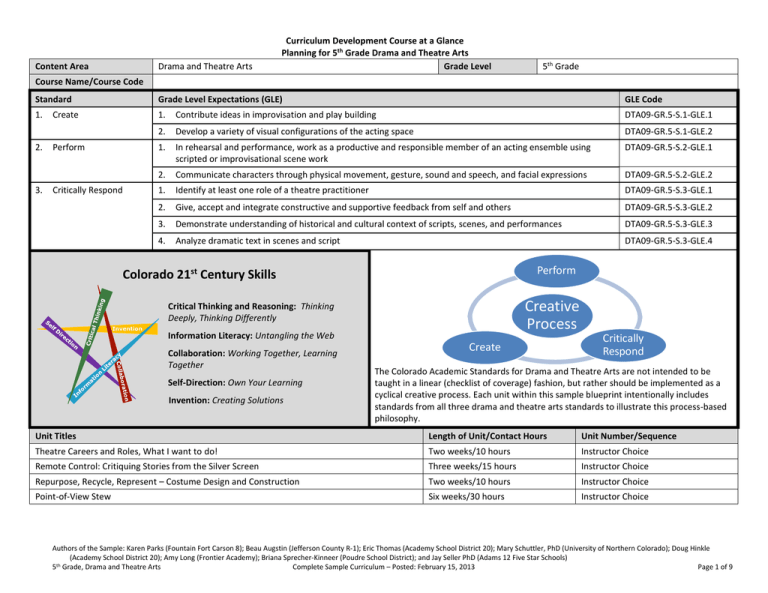
Content Area Drama and Theatre Arts Curriculum Development Course at a Glance Planning for 5th Grade Drama and Theatre Arts Grade Level 5th Grade Course Name/Course Code Standard Grade Level Expectations (GLE) GLE Code 1. 1. Contribute ideas in improvisation and play building DTA09-GR.5-S.1-GLE.1 2. Develop a variety of visual configurations of the acting space DTA09-GR.5-S.1-GLE.2 1. In rehearsal and performance, work as a productive and responsible member of an acting ensemble using scripted or improvisational scene work DTA09-GR.5-S.2-GLE.1 2. Communicate characters through physical movement, gesture, sound and speech, and facial expressions DTA09-GR.5-S.2-GLE.2 1. Identify at least one role of a theatre practitioner DTA09-GR.5-S.3-GLE.1 2. Give, accept and integrate constructive and supportive feedback from self and others DTA09-GR.5-S.3-GLE.2 3. Demonstrate understanding of historical and cultural context of scripts, scenes, and performances DTA09-GR.5-S.3-GLE.3 4. Analyze dramatic text in scenes and script DTA09-GR.5-S.3-GLE.4 2. 3. Create Perform Critically Respond Perform Colorado 21st Century Skills Creative Process Critical Thinking and Reasoning: Thinking Deeply, Thinking Differently Invention Information Literacy: Untangling the Web Collaboration: Working Together, Learning Together Self-Direction: Own Your Learning Invention: Creating Solutions Create Critically Respond The Colorado Academic Standards for Drama and Theatre Arts are not intended to be taught in a linear (checklist of coverage) fashion, but rather should be implemented as a cyclical creative process. Each unit within this sample blueprint intentionally includes standards from all three drama and theatre arts standards to illustrate this process-based philosophy. Unit Titles Length of Unit/Contact Hours Unit Number/Sequence Theatre Careers and Roles, What I want to do! Two weeks/10 hours Instructor Choice Remote Control: Critiquing Stories from the Silver Screen Three weeks/15 hours Instructor Choice Repurpose, Recycle, Represent – Costume Design and Construction Two weeks/10 hours Instructor Choice Point-of-View Stew Six weeks/30 hours Instructor Choice Authors of the Sample: Karen Parks (Fountain Fort Carson 8); Beau Augstin (Jefferson County R-1); Eric Thomas (Academy School District 20); Mary Schuttler, PhD (University of Northern Colorado); Doug Hinkle (Academy School District 20); Amy Long (Frontier Academy); Briana Sprecher-Kinneer (Poudre School District); and Jay Seller PhD (Adams 12 Five Star Schools) 5th Grade, Drama and Theatre Arts Complete Sample Curriculum – Posted: February 15, 2013 Page 1 of 9 Curriculum Development Overview Unit Planning for 5th Grade Drama and Theatre Arts Unit Title Theatre Careers and Roles, What I want to Do! Focusing Lens(es) Roles/Responsibilities Inquiry Questions (EngagingDebatable): Unit Strands Create, Perform, Critically Respond Concepts Influence, Contribution, Analysis, Vision, Investigate/Discovery, Production, Process, Technique, Style, Value, Law/Rules, Design, Collaboration Standards and Grade Level Expectations Addressed in this Unit Length of Unit 1-2 weeks/5 one hour sessions DTA09-GR.5-S.1-GLE.1, DTA09-GR.5-S.1-GLE.2 DTA09-GR.5-S.2-GLE.1, DTA09-GR.5-S.2-GLE.2 DTA09-GR.5-S.3-GLE.1, DTA09-GR.5-S.3-GLE.2, DTA09-GR.5-S.3-GLE.3, DTA09-GR.5-S.3-GLE.4 Why are there distinct roles in a theatrical production? (DTA09-GR.5-S.1-GLE.1,2) and (DTA09-GR.5-S.2-GLE.1,2) and (DTA09-GR.5-S.3-GLE.1,2,3,4) Why should performers experience various roles of a theatrical production? Generalizations My students will Understand that… Guiding Questions Factual Conceptual Numerous theatre practitioners influence and contribute to the creation of a production. (DTA09-GR.5-S.3-GLE.3) Who are the members of a production team? What is the job responsibility of each member of a production team? How can incorporating numerous informed voices assist in the creation of a production? Why is training for any job on the theatre production team essential? Investigation of various theatrical roles reveals that each aspect of a theatre practitioner’s skills and techniques are unique and valuable to the production process. (DTA09GR.5-S.1-GLE.2) and (DTA09-GR.5-S.2-GLE.1) and (DTA09GR.5-S.3-GLE.1,3) What are the unique aspects that playwrights, directors and actors contribute to a production? What are the unique aspects that designers and technicians contribute to a production? How does a designer dictate a technician’s job in a production?) How does a director analyze the playwright’s script for production? Designers and technicians collaborate with the director to discover and create the vision of the production. (DTA09GR.5-S.1-GLE.2) and (DTA09-GR.5-S.2-GLE.1) and (DTA09GR.5-S.3-GLE.1,2,3,4) What are the key components of successful collaboration? What is required to develop a vision for a production? How does the director/production team develop the vision for a production? Why is successful collaboration essential to the success of a production How does each member of a production team contribute to the overall theatre experience? Authors of the Sample: Karen Parks (Fountain Fort Carson 8); Beau Augstin (Jefferson County R-1); Eric Thomas (Academy School District 20); Mary Schuttler, PhD (University of Northern Colorado); Doug Hinkle (Academy School District 20); Amy Long (Frontier Academy); Briana Sprecher-Kinneer (Poudre School District); and Jay Seller PhD (Adams 12 Five Star Schools) 5th Grade, Drama and Theatre Arts Complete Sample Curriculum – Posted: February 15, 2013 Page 2 of 9 Curriculum Development Overview Unit Planning for 5th Grade Drama and Theatre Arts Critical Content: Key Skills: My students will Know… My students will be able to (Do)… The different roles of theatre practitioners on a production team (such as director, playwright, designer (set, sound, lighting, costume, make-up), technician, stage manager) (DTA09-GR.5-S.3-GLE.1,2,3) The specific job responsibilities of the theatre practitioners on a production team (DTA09-GR.5-S.1-GLE.2) and (DTA09-GR.5-S.2-GLE.1) and (DTA09-GR.5-S.3GLE.1,2,3) The key components of successful collaboration for members on a production team (such as team work, give and take, respect, critical thinking) (DTA09-GR.5S.1-GLE.2) and (DTA09-GR.5-S.2-GLE.1) and (DTA09-GR.5-S.3-GLE.1,2,3) The process of creating a vision for a theatre production (such as research, culture, history, imagination) (DTA09-GR.5-S.1-GLE.2) and (DTA09-GR.5-S.2-GLE.1) and (DTA09-GR.5-S.3-GLE.1,2,3) Identify the unique duties and contributions of each member of a production team. (DTA09-GR.5-S.1-GLE.2) and (DTA09-GR.5-S.2-GLE.1) and (DTA09-GR.5-S.3GLE.1,2,3)Articulate the process of developing a vision for a production in collaboration with designers on a production team. (DTA09-GR.5-S.1-GLE.2) and (DTA09-GR.5-S.2-GLE.1) and (DTA09-GR.5-S.3-GLE.1,2,3) Exhibit an understanding of the importance of collaboration in a theatrical context. (DTA09-GR.5-S.1-GLE.2) and (DTA09-GR.5-S.2-GLE.1) and (DTA09-GR.5-S.3GLE.1,2,3) Identify how a designer’s role is different from a technician’s role in the production process. (DTA09-GR.5-S.1-GLE.2) and (DTA09-GR.5-S.2-GLE.1) and (DTA09-GR.5S.3-GLE.1,2,3) Identify how a director contributes to the actor’s process of creating a character (DTA09-GR.5-S.1-GLE.2) and (DTA09-GR.5-S.2-GLE.1) and (DTA09-GR.5-S.3GLE.1,2,3) Identify how a playwright informs the production team of the play’s message (DTA09-GR.5-S.1-GLE.2) and (DTA09-GR.5-S.2-GLE.1) and (DTA09-GR.5-S.3GLE.1,2,3) Critical Language: includes the Academic and Technical vocabulary, semantics, and discourse which are particular to and necessary for accessing a given discipline. EXAMPLE: A student in Language Arts can demonstrate the ability to apply and comprehend critical language through the following statement: “Mark Twain exposes the hypocrisy of slavery through the use of satire.” A student in ______________ can demonstrate the ability to apply and comprehend critical language through the following statement(s): Creating a successful vision for a theatrical production involves the collaboration of the director with the entire production team. Academic Vocabulary: Collaboration, critical thinking Technical Vocabulary: Theatre practitioners, theatre designers and technicians, production team (playwright, director, designer (set, sound, lighting, costume, make-up), technician, stage manager) Authors of the Sample: Karen Parks (Fountain Fort Carson 8); Beau Augstin (Jefferson County R-1); Eric Thomas (Academy School District 20); Mary Schuttler, PhD (University of Northern Colorado); Doug Hinkle (Academy School District 20); Amy Long (Frontier Academy); Briana Sprecher-Kinneer (Poudre School District); and Jay Seller PhD (Adams 12 Five Star Schools) 5th Grade, Drama and Theatre Arts Complete Sample Curriculum – Posted: February 15, 2013 Page 3 of 9 Curriculum Development Overview Unit Planning for 5th Grade Drama and Theatre Arts Unit Title Stories from the Silver Screen Focusing Lens(es) Structure and Function Inquiry Questions (EngagingDebatable): Unit Strands Create, Perform, Critically Respond Concepts Investigate/Discovery, Story, Cultural/Historical, Complexity, Expressions, Production, Attributes, Problem Solving, Technique, Motivation, Dramatic Elements, Texture, Character, Environment Length of Unit Standards and Grade Level Expectations Addressed in this Unit 3 weeks/15 hours DTA09-GR.5-S.1-GLE.1, DTA09-GR.5-S.1-GLE.2 DTA09-GR.5-S.2-GLE.1, DTA09-GR.5-S.2-GLE.2 DTA09-GR.5-S.3-GLE.1, DTA09-GR.5-S.3-GLE.2, DTA09-GR.5-S.3-GLE.3, DTA09-GR.5-S.3-GLE.4 How is a story explored through film/stage adaptation? (DTA09-GR.5-S.1-GLE.1,2) and (DTA09-GR.5-S.2-GLE.1,2) and (DTA09-GR.5-S.3-GLE.1,2,3,4) How do different directors make choices in a film/play? What are the most important jobs when creating a play/film? Generalizations My students will Understand that… Guiding Questions Factual Conceptual Theatrical/film practitioners utilize techniques to artistically express moments in story (DTA09-GR.5-S.1GLE. 2) and (DTA09-GR.5-S.2-GLE.1) and (DTA09-GR.5-S.3GLE. 2,3,4) Who is in charge of a theatrical/film production? What are the different theatre/film careers? What are the major techniques each theatre/film practitioner utilizes? What do theatre/film practitioners do to contribute to a production? How can theatrical/film practitioners use historical and cultural understandings to enhance their artistic expressions? What are the professional attributes associated with different theatre/film practitioners? Gestures, facial expressions, and sounds techniques influence believability of characters (DTA09-GR.5-S.1GLE.1) and (DTA09-GR.5-S.2-GLE.2) and (DTA09-GR.5-S.3GLE.2,3) What facial expressions, gestures, and sounds communicate varying emotions? What makes a character believable? What sounds inhabit various characters’ environments? How do characters communicate motivation? How is cultural and historical understanding important when creating authentic character rhythms? How can constructive feedback enhance authenticity of characters? Unifying a variety of elements in a production creates a complex and textured composition (DTA09-GR.5-S.1GLE.2) and (DTA09-GR.5-S.2-GLE.1) and (DTA09-GR.5-S.3GLE.1,2,) What are the different perspectives that are expressed in a theatrical/film production? How can theatrical/film practitioners merge their work to create a unified production? How do theatrical/film practitioners solve problems and build consensus? How do theatrical/film practitioners develop and give constructive feedback? Authors of the Sample: Karen Parks (Fountain Fort Carson 8); Beau Augstin (Jefferson County R-1); Eric Thomas (Academy School District 20); Mary Schuttler, PhD (University of Northern Colorado); Doug Hinkle (Academy School District 20); Amy Long (Frontier Academy); Briana Sprecher-Kinneer (Poudre School District); and Jay Seller PhD (Adams 12 Five Star Schools) 5th Grade, Drama and Theatre Arts Complete Sample Curriculum – Posted: February 15, 2013 Page 4 of 9 Curriculum Development Overview Unit Planning for 5th Grade Drama and Theatre Arts Critical Content: Key Skills: My students will Know… My students will be able to (Do)… Different theatre/film careers (DTA09-GR.5-S.3-GLE.1) Collaborative process in theatre/film (DTA09-GR.5-S.2-GLE.1) Improvisation techniques and purposes (DTA09-GR.5-S.1-GLE.1) Why critique is important to theatrical/film productions (DTA09-GR.5-S.3-GLE.2) Importance of research in film/theatrical productions (DTA09-GR.5-S.3-GLE.3,4) Improvise and imitate scenes from a story (historical or fictional) (DTA09-GR.5-S.1GLE.1) and (DTA09-GR.5-S.2-GLE.2) and (DTA09-GR.5-S.3-GLE. 3,4) Use improvisation skills to reveal understanding of artistic choices (DTA09-GR.5S.1-GLE.1) and (DTA09-GR.5-S.2-GLE.2) and (DTA09-GR.5-S.3-GLE.1) Critique artistic choices from source material as a theater/film practitioner (DTA09GR.5-S.3-GLE.1,2,3,4) Explore artistic choices in an adapted scene through ensemble improvisation of theatre professional (DTA09-GR.5-S.1-GLE.1) and (DTA09-GR.5-S.2-GLE.2) and (DTA09-GR.5-S.3-GLE.1) Work effectively in an ensemble to improvise a scene adapted from source material as theatre professionals (DTA09-GR.5-S.1-GLE.1) and (DTA09-GR.5-S.2GLE.2) and (DTA09-GR.5-S.3-GLE.1) Use historical and cultural research to authentically adapt source material (DTA09GR.5-S.3-GLE. 3,4) Critical Language: includes the Academic and Technical vocabulary, semantics, and discourse which are particular to and necessary for accessing a given discipline. EXAMPLE: A student in Language Arts can demonstrate the ability to apply and comprehend critical language through the following statement: “Mark Twain exposes the hypocrisy of slavery through the use of satire.” A student in ______________ can demonstrate the ability to apply and comprehend critical language through the following statement(s): Recreating major moments in a common story through film is accomplished through ensemble collaboration, research, and discussion of artistic decisions. Academic Vocabulary: Film, characters, critique, context, artistic, gestures, environments, research, plot elements Technical Vocabulary: Improvisation, roles, playwright, actor, director, designers, lighting, improvisation terms(play, pause, rewind, slow motion, fast forward) Authors of the Sample: Karen Parks (Fountain Fort Carson 8); Beau Augstin (Jefferson County R-1); Eric Thomas (Academy School District 20); Mary Schuttler, PhD (University of Northern Colorado); Doug Hinkle (Academy School District 20); Amy Long (Frontier Academy); Briana Sprecher-Kinneer (Poudre School District); and Jay Seller PhD (Adams 12 Five Star Schools) 5th Grade, Drama and Theatre Arts Complete Sample Curriculum – Posted: February 15, 2013 Page 5 of 9 Curriculum Development Overview Unit Planning for 5th Grade Drama and Theatre Arts Unit Title Repurpose, Recycle, Represent: Costume Design and Construction Focusing Lens(es) Identity Inquiry Questions (EngagingDebatable): Unit Strands Create, Perform, Critically Respond Concepts Composition, Expressions, Order/ Form. Shape, Texture, Movement, Design, Construction, Character Elements, Planning, Vision, Detail, Structure Standards and Grade Level Expectations Addressed in this Unit Length of Unit 8-10 days/ hours DTA09-GR.5-S.1-GLE.1, DTA09-GR.5-S.1-GLE.2 DTA09-GR.5-S.2-GLE.1, DTA09-GR.5-S.2-GLE.2 DTA09-GR.5-S.3-GLE.1, DTA09-GR.5-S.3-GLE.2, DTA09-GR.5-S.3-GLE.3, DTA09-GR.5-S.3-GLE.4 Why would some say costumes are an additional character of a production? (DTA09-GR.5-S.2-GLE.1,2) and (DTA09-GR.5-S.3-GLE.1,2,3,4) How do costuming decisions effect a production? Do costumes have a voice? Generalizations My students will Understand that… Guiding Questions Factual Conceptual Shape and texture contribute to the visual interest of a character’s costume and often identify key character elements. (DTA09-GR.5-S.1-GLE.1) and (DTA09-GR.5-S.3GLE.1,2) What words can describe the texture and shape of one part of a costume? What are the criteria of an interesting costume? How can designers repurpose materials to create costumes? How can designers use different elements (color, texture, and shape, movement) to create an interesting costume? Planning an order of steps and forming a list of required supplies dictates the design and construction of a costume to align to the vision of the actors and directors. (DTA09-GR.5-S.1-GLE.1) and (DTA09-GR.5-S.3-GLE.1,2) What are the steps necessary in costume construction? What is the effect of reordering the steps during costume construction? What are the norms for collaborating on a design? How does creating consensus on a design team lead to greater ownership of a production? How do you create norms for collaboration? Attention to details such as texture, shape, movement, and color in design leads to clear expression during collaboration regarding the vision of actors and directors for each character. (DTA09-GR.5-S.1-GLE.1) and (DTA09GR.5-S.3-GLE.2,4) What words can describe how a costume moves on stage? What happens when designers don’t clearly express their ideas? How do colors communicate mood? How have costume-details (texture, shape, movement, and color) changed through time? Authors of the Sample: Karen Parks (Fountain Fort Carson 8); Beau Augstin (Jefferson County R-1); Eric Thomas (Academy School District 20); Mary Schuttler, PhD (University of Northern Colorado); Doug Hinkle (Academy School District 20); Amy Long (Frontier Academy); Briana Sprecher-Kinneer (Poudre School District); and Jay Seller PhD (Adams 12 Five Star Schools) 5th Grade, Drama and Theatre Arts Complete Sample Curriculum – Posted: February 15, 2013 Page 6 of 9 Curriculum Development Overview Unit Planning for 5th Grade Drama and Theatre Arts Critical Content: Key Skills: My students will Know… My students will be able to (Do)… The basic costume design steps inherent to pre-production, production, and performance (DTA09-GR.5-S.2-GLE.1) and (DTA09-GR.5-S.3-GLE.1,2) The contributions of color, shape, movement, and texture in a costume to characterization and a theatre production’s theme(DTA09-GR.5-S.2-GLE.1) and (DTA09-GR.5-S.3-GLE.3,4) Costumes have changed throughout history (DTA09-GR.5-S.2-GLE.1) and (DTA09GR.5-S.3-GLE.3) The norms for collaborating on a design team (DTA09-GR.5-S.2-GLE.1) and (DTA09GR.5-S.3-GLE.2) Follow steps to construct a costume from a design. (DTA09-GR.5-S.2-GLE.1) and (DTA09-GR.5-S.3-GLE.1) Identify color, shape, movement, and texture in items in order to repurpose them as costume pieces. (DTA09-GR.5-S.3-GLE.1,2,3,4) Identify the essential qualities of a character in order to make informed artistic choices about color, shape, movement, and texture) (DTA09-GR.5-S.2-GLE.1) and (DTA09-GR.5-S.3-GLE.3) Create and follow norms to create consensus within a design team. (DTA09-GR.5S.2-GLE.1) and (DTA09-GR.5-S.3-GLE.2) Critical Language: includes the Academic and Technical vocabulary, semantics, and discourse which are particular to and necessary for accessing a given discipline. EXAMPLE: A student in Language Arts can demonstrate the ability to apply and comprehend critical language through the following statement: “Mark Twain exposes the hypocrisy of slavery through the use of satire.” A student in ______________ can demonstrate the ability to apply and comprehend critical language through the following statement(s): Creating costumes helps me bring the character I am researching come to life. Academic Vocabulary: Expression, collaboration, design, create, color, movement, texture, shape, consensus, repurpose, recycle, norms, character, characterization Technical Vocabulary: Costume, costume pieces, design, design team, historical context, theatre production; pre-production, performance Authors of the Sample: Karen Parks (Fountain Fort Carson 8); Beau Augstin (Jefferson County R-1); Eric Thomas (Academy School District 20); Mary Schuttler, PhD (University of Northern Colorado); Doug Hinkle (Academy School District 20); Amy Long (Frontier Academy); Briana Sprecher-Kinneer (Poudre School District); and Jay Seller PhD (Adams 12 Five Star Schools) 5th Grade, Drama and Theatre Arts Complete Sample Curriculum – Posted: February 15, 2013 Page 7 of 9 Curriculum Development Overview Unit Planning for 5th Grade Drama and Theatre Arts Unit Title Point-of-View Stew Focusing Lens(es) Perspective Inquiry Questions (EngagingDebatable): Unit Strands Create, Perform, Critically Respond Concepts Culture, Paradox, Point of View, Character, Scene, Dramatic, Contrasting, Values Length of Unit Standards and Grade Level Expectations Addressed in this Unit 6 Weeks/30 hours DTA09-GR.5-S.1-GLE.1, DTA09-GR.5-S.1-GLE.2, DTA09-GR.5-S.1-GLE.3 DTA09-GR.5-S.2-GLE.1, DTA09-GR.5-S.2-GLE.2 DTA09-GR.5-S.3-GLE.1, DTA09-GR.5-S.3-GLE.2, DTA09-GR.5-S.3-GLE.3, DTA09-GR.5-S.3-GLE.4 How can diverse perspectives help us understand what happened in the past, for the purpose of recreation on the stage? (DTA09-GR.5-S.1-GLE.1,2) and (DTA09-GR.5-S.2-GLE.1,2) and (DTA09-GR.5-S.3-GLE.1,2,3,4) What influences perspective or point-of-view for a theatrical production? How does point-of-view influence character or scene development in a dramatic production? Generalizations My students will Understand that… Guiding Questions Factual Conceptual Cultural perspective of a specific character’s point of view (such as opposing soldiers in a war) expands character and scene development in a dramatic presentation. (DTA09-GR.5-S.1-GLE.1,2) and (DTA09-GR.5-S.2-GLE.1,2) and (DTA09-GR.5-S.3-GLE.3,4) What cultural perspectives are relevant to American History? (Such as the point of view of colonists from Jamestown vs. Plymouth) What types of cultural perspectives lend themselves to demonstrating cultural conflict? How can an audio script be used to demonstrate cultural conflict? (Such as a radio play/drama) How does historical background of a character determine performance decisions? A paradox presented through contrasting points-of-view in a theatrical performance will demonstrate personal and cultural values of characters. (DTA09-GR.5-S.1-GLE.1,2) and (DTA09-GR.5-S.2-GLE.1,2) and (DTA09-GR.5-S.3GLE.3,4) What body movements and voice intonations can a character use to show intense conflict? What kind of character placements on a stage can be used to demonstrate contrasting viewpoints? How does point-of-view impact the nature of a character in a performance? (Such as Native American vs. Puritan; Slave vs. Slave Owner vs. Abolitionist) How can conflict be demonstrated on stage? Improvisation can often define key character elements regarding cultural expressions in a theatrical performance by allowing an actor to explore various ways a character might react. (DTA09-GR.5-S.1-GLE.1,2) and (DTA09-GR.5S.2-GLE.1,2) and (DTA09-GR.5-S.3-GLE.3,4) What tools does a theater practitioner use to enhance mood or texture of a scene? What are the different roles of theater practitioners? (Such as actor, director, set designers, sound effects, production engineer, vocalists, playwright) How does a theater practitioner contribute to the content of a theatrical performance? How can lighting, set design, and sound effects enhance the paradox of a scene? Authors of the Sample: Karen Parks (Fountain Fort Carson 8); Beau Augstin (Jefferson County R-1); Eric Thomas (Academy School District 20); Mary Schuttler, PhD (University of Northern Colorado); Doug Hinkle (Academy School District 20); Amy Long (Frontier Academy); Briana Sprecher-Kinneer (Poudre School District); and Jay Seller PhD (Adams 12 Five Star Schools) 5th Grade, Drama and Theatre Arts Complete Sample Curriculum – Posted: February 15, 2013 Page 8 of 9 Curriculum Development Overview Unit Planning for 5th Grade Drama and Theatre Arts Critical Content: Key Skills: My students will Know… My students will be able to (Do)… The different interpretations of History based upon individual or societal perspectives that are exhibited through theatrical performance. (DTA09-GR.5-S.1GLE.1,2) and (DTA09-GR.5-S.2-GLE.1,2) and (DTA09-GR.5-S.3-GLE.3,4) Ways in which theatrical performances have the ability to show how diversity has impacted historical events. (DTA09-GR.5-S.3-GLE.4) How lighting and sound influences theatrical mood and content (DTA09-GR.5-S.1GLE.1) and (DTA09-GR.5-S.3-GLE.3) The contributions of body movement and stage placement to thoughtful character interpretation. (DTA09-GR.5-S.1-GLE.2) and (DTA09-GR.5-S.2-GLE.1,2) Portray diverse cultural historical perspectives in a theatrical performance. (DTA09-GR.5-S.1-GLE.1,2) and (DTA09-GR.5-S.2-GLE.1,2) and (DTA09-GR.5-S.3GLE.3,4) Create characters that convey historical conflict from multiple perspectives. (DTA09-GR.5-S.1-GLE.1,2) and (DTA09-GR.5-S.2-GLE.1,2) and (DTA09-GR.5-S.3GLE.3,4) Analyze script and performance content for paradoxical points-of-view. (DTA09GR.5-S.3-GLE.1,2,3,4) Identify multiple theater practitioner roles and their effect on performance. . (DTA09-GR.5-S.3-GLE.1,2,3,4) Critical Language: includes the Academic and Technical vocabulary, semantics, and discourse which are particular to and necessary for accessing a given discipline. EXAMPLE: A student in Language Arts can demonstrate the ability to apply and comprehend critical language through the following statement: “Mark Twain exposes the hypocrisy of slavery through the use of satire.” A student in ______________ can demonstrate the ability to apply and comprehend critical language through the following statement(s): Historical conflict between Native Americans (or insert different character perspective) and European Settlers (or insert different character perspective) is represented through emotional characterizations of relationships on stage. Academic Vocabulary: Historical conflict, multiple perspectives, paradox Technical Vocabulary: Critique, theater practitioner, characterization, designers, sound effects, production engineer, playwright Authors of the Sample: Karen Parks (Fountain Fort Carson 8); Beau Augstin (Jefferson County R-1); Eric Thomas (Academy School District 20); Mary Schuttler, PhD (University of Northern Colorado); Doug Hinkle (Academy School District 20); Amy Long (Frontier Academy); Briana Sprecher-Kinneer (Poudre School District); and Jay Seller PhD (Adams 12 Five Star Schools) 5th Grade, Drama and Theatre Arts Complete Sample Curriculum – Posted: February 15, 2013 Page 9 of 9


